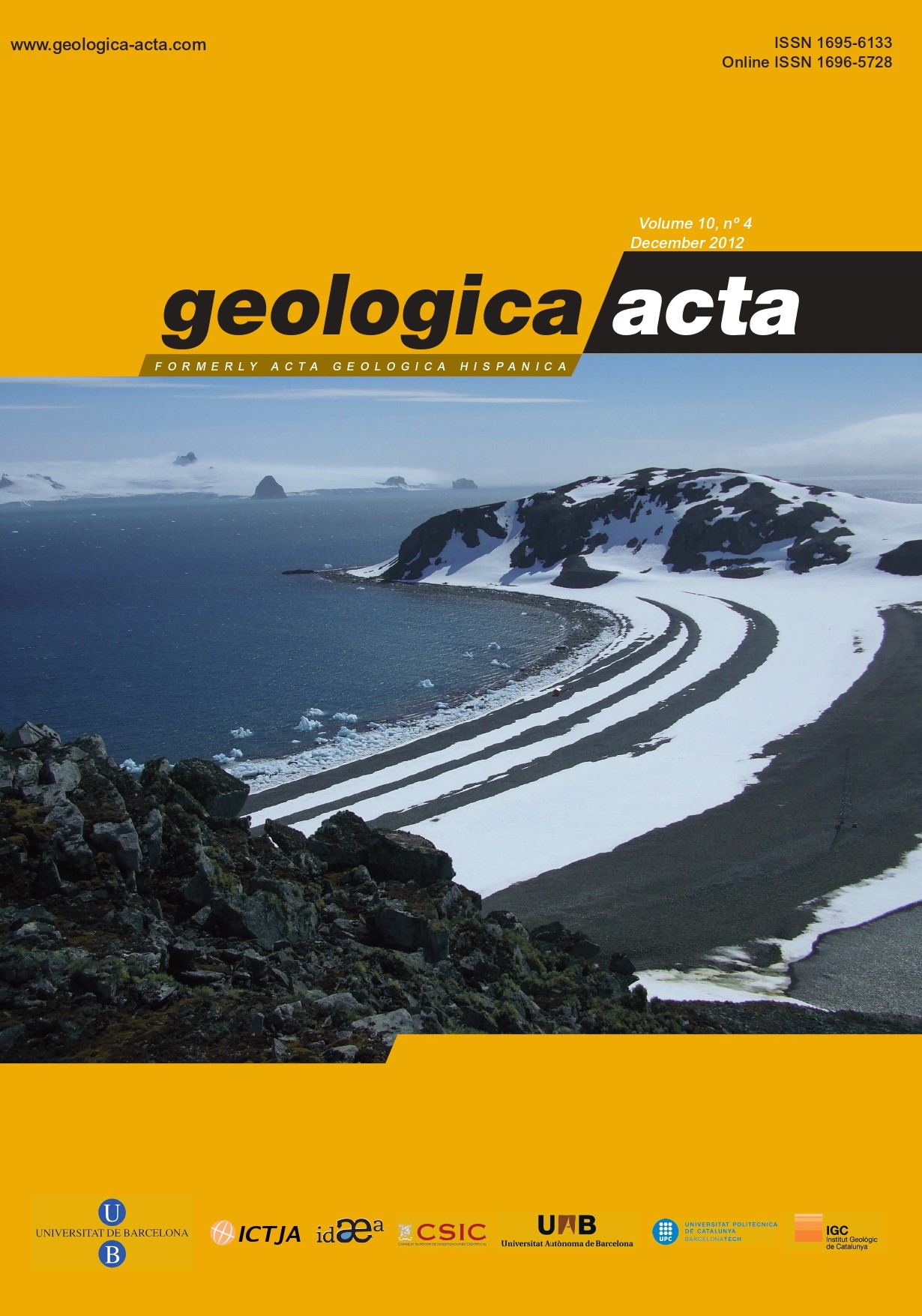Carbon and oxygen isotopic composition of the Middle Miocene Badenian gypsum-associated limestones of West Ukraine
DOI:
https://doi.org/10.1344/105.00000175Keywords:
Middle Miocene, Ukraine, Sedimentology, Limestones, Stable isotopes, GypsumAbstract
The Middle Miocene Badenian basin of the Carpathian Foredeep is characterized by complex sedimentary and diagenetic carbonate-evaporite transitions. Six locations have been selected to evaluate the controls on the carbon and oxygen isotopic composition of the Badenian gypsum-associated limestones of the Tyras Formation in West Ukraine. At three locations marine limestones overlie the gypsum, at one location (Anadoly) the gypsum-associ-ated limestones are polygenic, and at two locations (Pyshchatyntsi and Lozyna) gypsum deposits are lacking. The studied limestones have originated as primary, mostly peloidal carbonates as well as secondary carbonates formed by hypogene sulphate calcitization. They show a wide range of δ13C (from from -0.9‰ to -39.8‰) and δ18O values (from 0.9‰ to -12.2‰). The Badenian limestones formed in marine environments (either as deposits ac-cumulated at the bottom of the sea or forming the infillings of solution cavities within gypsum) have less negative δ18O values compared to predominantly diagenetic formations. Wide ranges and usually very negative δ13C values and low δ18O values of those limestones indicate that they suffered important meteoric diagenesis as supported by common sparitic fabrics. In addition, a large range of δ13C values even in the group of samples characterized by less-negative δ18O values shows that bacterial sulphate reduction and methane oxidation were active processes in the pore fluids of the Tyras Formation. Very low carbon isotopic compositions (δ13C values from -22 to -40‰) of some sparitic limestones in the studied sections indicate the occurrence of oxidized methane within the diagenetic environment. Accordingly, the isotopic signatures of the studied limestones are a combination of both primary and secondary processes, the latter having a primordial importance. The common occurrence of similar negative δ13C and δ18O values in evaporite-related carbonates in other Miocene evaporite basins suggest that extensive dissolu-tion-reprecipitation in diagenetic or vadose-phreatic environments was common in evaporite-related carbonates.References
Aleksenko, I.I., 1961. Sulphur of the Forecarpathians (in Russian). Moskva, Niedra, 303pp.
Andreyeva-Grigorovich, A.S., Kulchytsky, Y.O., Gruzman, A.D., Lozynyak, P.Y., Petrashkevich, M.I., Portnyagina, L.O., Ivanina, A.V., Smirnov, S.E., Trofimovich, N.A., Savitskaya, N.A., Shvareva, N.J., 1997. Regional stratigraphic scheme of Neogene formations of the Central Paratethys in the Ukraine. Geologica Carpathica, 48, 123-136.
Armstrong-Altrin, J.S., Lee, Y.I., Verma, S.P., Worden, R.H., 2009. Carbon, oxygen, and strontium isotope geochemistry of carbonate rocks of the upper Miocene Kudankulam Formation, southern India: Implications for paleoenvironment and diagenesis. Chemie der Erde, 69, 45-60.
Arthur, M.A., Anderson, T.F., Kaplan, I.R., Veizer, J., Land, L.S., 1983. Stable isotopes in sedimentary geology. Society of Economic Paleontologists and Mineralogists, 10 (Short Course), 1-435.
Bąbel, M., 2005. Event stratigraphy of the Badenian selenite evaporites (Middle Miocene) of the northern Carpathian Foredeep. Acta Geologica Polonica, 55, 9-29.
Bąbel, M., 2007. Depositional environments of a salina-type evaporite basin recorded in the Badenian gypsum facies in the northern Carpathian Foredeep. London, Geological Society, 285 (Special Publications), 107-142.
Bobrovnik, D.P., 1966. About supra-gypsum (Ratyn) Limestone of the southwest margin of the Russian Platform. In: Koltun, V.I. (ed.). Geology and geochemistry of the Forecarpathian sulphur deposits (in Russian). Kiev, Naukova Dumka, 3-11.
Buonocunto, F.P., Sprovieri, M., Bellanca, A., d’Argenio, B., Ferrari, V., Neri, R., Ferruzza, G., 2002. Cyclostratigraphy and high-frequency carbon isotope fluctuations in Upper Cretaceous shallow-water carbonates, southern Italy. Sedimentology, 49, 1321-1337.
Decima, A., McKenzie, J.A., Schreiber, B.C., 1988. The origin of “evaporative” limestones: an example from the Messinian of Sicily (Italy). Journal of Sedimentary Petrology, 58, 256-272.
Gąsiewicz, A., 2000. Sedimentology and diagenesis of gypsum-ghost limestones and origin of Polish native sulphur deposits (in Polish). Prace Państwowego Instytutu Geologicznego, 172, 1-143.
Gerasimov, L.S., Makarova, I.V., Chalyi, S.V., Plotnikov, A.S., Gerasimova, I.I., Polkunova, G.V., Yevtushko, T.L., 2005. State Geological Map of Ukraine (in Ukrainian). 1:200,000. Kyiv, Carpathian Series, Sheets M-34-XXIII (Przemyśl), M-34-XXIV (Drohobych).
Gischler, E., Swart, P.K., Lomando, A.J., 2009. Stable isotopes of carbon and oxygen in modern sediments of carbonate platforms, barrier reefs, atolls, and ramps: patterns and implications. International Association of Sedimentologists, 41 (Special Publications), 61-74.
Jassim, S.Z., Raiswell, R., Bottrell, S.H., 1999. Genesis of the Middle Miocene stratabound sulphur deposits of northern Iraq. Journal of the Geological Society of London, 156, 25-39.
Kim, S.-T., O’Neil, J.R., 1997. Equilibrium and nonequilibrium oxygen isotope effects in synthetic carbonates. Geochimica et Cosmochimica Acta, 61, 3461-3475.
Klimchouk, A.B., 1997. The role of karst in the genesis of sulfur deposits, Pre-Carpathian region, Ukraine. Environmental Geology, 31, 1-20.
Klimchouk, A.B., Aksem, S.D., 2001. Gypsum karst in the western Ukraine: hydrochemistry and solution rates. In: Günay, G., Johnson, K.S., Ford, D., Johnson, A.I. (eds.). Present state and future trends of karst studies. International Hydrological Programme-V Technical Documents in Hydrology, 49(I), 67-80.
Koltun, V.I., 1965. About the genesis of sulphur-bearing limestones of Pridnestrovye in relation to study of their textural features (in Russian). Mineralogicheskiy sbornik, 19(1), 93-94.
Koltun, V.I., Roskosh, Y.T., Sen’kovskyy, Y.M., Yasins’ka, A.A., 1972. Lithogenesis of sulphur deposits of the Pre-Carpathians (in Ukrainian). Kiev, Naukova Dumka, 156pp.
Ková ová, P., Emanuel, L., Hudá ková, N., Renard, M., 2009. Central Paratethys paleoenvironment during the Badenian (Middle Miocene): evidence from foraminifera and stable isotope (δ13C and δ18O) study in the Vienna Basin (Slovakia). International Journal of Earth Sciences, 98, 1109-1127.
Kubica, B., 1997. Relation of sulfur-forming processes to lithofacies and structural features of Badenian chemical sediments in the Carpathian Foredeep (Poland). Slovak Geological Magazine, 3, 121-130.
Kudrin, L.N., 1955. Upper Tortonian gypsum of the southwest margin of the Russian Platform (in Russian). Uchenyye Zapiski Lvovskogo Gosudarstvennogo Universiteta im. Ivana Franko, 35, 129-161.
Kudrin, L.N., 1966. Stratigraphy, facies and ecological analysis of fauna of the Paleogene and Neogene deposits of the Forecarpathians (in Russian). Lvov, Izdatelstvo Lvovskogo Universiteta, 174pp.
Latal, C., Piller, W.E., Harzhauser, M., 2004. Palaeoenvironmental reconstructions by stable isotopes of Middle Miocene gastropods of the Central Paratethys. Palaeogeography, Palaeoclimatology, Palaeoecology, 211, 157-169.
Lein, A.Y., Ivanov, M.V., Rivkina, E.M., Bondar, V.A., 1977. Differences in isotope composition of carbon of pelitomorphic and crystalline limestones of sulphur deposits in the Pre-Carpathians (in Russian). Geokhimiya, 4, 578-588.
Łomnicki, A.M., 1897. Geological Atlas of Galicia (in Polish). Kraków, Polska Akademia Umiej tno ci, 10(2), 208pp.
McCrea, J.M., 1950. On the isotopic geochemistry of carbonates and a paleotemperature scale. Journal of Chemical Physics, 18, 849-857.
Montana, G., Censi, P., Bellia, S., 1994. Stable isotope geochemistry and mineralogy of some Messinian evaporitic carbonate outcrops in North Eastern Sicily. Geologica Carpathica, 45, 3-9.
Nowak, J., 1938. Dniestr and Tortonian gypsum (in Polish). Annales de la Société Géologique de Pologne, 14, 155-194.
Oszczypko, N., Krzywiec, P., Popadyuk, I., Peryt, T., 2006. Carpathian Foredeep Basin (Poland and Ukraine): Its sedimentary, structural and geodynamic evolution. American Association of Petroleum Geologists, 84 (Memoir), 293-350.
Pawlikowski, M., Przybyłowicz, W., 1979. Mineral and isotopic composition of Miocene limestones from Wydrza sulphur deposits. Mineralogia Polonica, 10, 99-108.
Pawlowski, S., Pawlowska, K., Kubica, B., 1979. Geology and genesis of the Polish sulfur deposits. Economic Geology, 74, 475-483.
Peryt, D., Peryt, T.M., 2009. Environmental changes in the declining Middle Miocene Badenian evaporite basin of the Ukrainian Carpathian Foredeep (Kudryntsi section). Geologica Carpathica, 60, 505-517.
Peryt, T.M., 1996. Sedimentology of Badenian (middle Miocene) gypsum in eastern Galicia, Podolia and Bukovina (West Ukraine). Sedimentology, 43, 571-588.
Peryt, T.M., 2001. Gypsum facies transitions in basin-marginal evaporites: middle Miocene (Badenian) of west Ukraine. Sedimentology, 48, 1103-1119.
Peryt, T.M., 2006a. The beginning, development and termination of the Middle Miocene Badenian salinity crisis in Central Paratethys. Sedimentary Geology, 188-189, 379-396.
Peryt, T.M., 2006b. Ratyn Mount outcrop. In: Wysocka, A., Jasionowski, M. (eds.). Pattern and Variability of Sedimentation in Fore-Mountain Basins (in Polish). Zwierzyniec, 20-23.06.2006, Grodzisk Mazowiecki, conference volume, 49-52.
Peryt, T.M., Peryt, D., 1994. Badenian (Middle Miocene) Ratyn Limestone in western Ukraine and northern Moldavia: microfacies, calcareous nannoplankton and isotope geochemistry. Bulletin of the Polish Academy of Sciences, Earth Sciences, 42, 127-136.
Petrichenko, O.I., Peryt, T.M., Poberegsky, A.V., 1997. Pecularities of gypsum sedimentation in the Middle Miocene Badenian evaporite basin of Carpathian Foredeep. Slovak Geological Magazine, 3, 91-104.
Petryczenko, O.I., Panow, G.M., Peryt, T.M., Serebrodolski, B.I., Pobere ski, A.W., Kowalewicz, W.M., 1994. Outline of geology of the Miocene evaporite formations of the Ukrainian part of the Carpathian Foredeep (in Polish). Przeglad Geologiczny, 42, 734-737.
Pierre, C., Rouchy, J.M., 1988. Carbonate replacements after sulfate evaporites in the Middle Miocene of Egypt. Journal of Sedimentary Petrology, 58, 446-456.
Polkunov, V.F., 1990. Evaporite-terrigenous-carbonate formation. Neogene (in Russian). In: Chebanenko, I.I. (ed.). Geotectonics of Volhyn-Podolia. Kiev, Naukowa Dumka, 132-136.
Prysjazhnjuk, V.A., 1998. Tyrassian Suite of Precarpathian Region. Geologichnyi zhurnal, 1-2, 130-136.
Rouchy, J.M., Taberner, C., Peryt, T.M., 2001. Sedimentary and diagenetic transitions between carbonates and evaporites. Sedimentary Geology, 140, 1-8.
Scholle, P.A., Ulmer, D.S., Melim, L.A., 1992. Late-stage calcites in the Permian Capitan Formation and its equivalents, Delaware Basin margin, west Texas and New Mexico: evidence for replacement of precursor evaporites. Sedimentology, 39, 207-234.
Sidorenko, M.D., 1904. Description of some minerals and rocks from gypsum deposits of the Khotyn district, Bessarabia province (in Russian). Zapiski Novorosiyskogo Obshchestva Ispytateley Prirody, 27, 1-109.
Stafford, K.W., Ulmer-Scholle, D., Rosales-Lagarde, L., 2008. Hypogene calcitization: evaporite diagenesis in the western Delaware Basin. Carbonates and Evaporites, 23, 89-103.
Suarez, M.B., González, L.A., Ludvigson, G.A., Vega, F.J., Alvarado-Ortega, J., 2009. Isotopic composition of low-latitude paleoprecipitation during the Early Cretaceous. Bulletin of the Geological Society of America, 121, 1584-1595.
Teisseyre, H., 1938. Some questions of paleogeography of southern Roztocze (in Polish). Annales de la Société Géologique de Pologne, 14, 113-154.
Vashchenko, V.O., Turchynova, S.M., Turchynov, I.I., Polikha, G.G., 2007. State Geological Map of Ukraine (in Ukrainian). 1:200,000. Kyiv, Carpathian Series, Sheet M-35-XXV (Ivano-Frankivs’k).
Venglinskiy, I.V., Goretskiy, V.A., 1979. Stratotypes of Miocene deposits of the Volhyn-Podolia Plate, Carpathian Foredeep and Transcarpathian Deep (in Russian). Kiev, Naukova Dumka, 174pp.
Vinogradov, A.P., Grinienko, V.A., Ustinov, V.I., 1961. Genesis of Pre-Carpathian sulphur deposits by isotope composition of S32/34 and C12/13 (in Russian). Geokhimia, 10, 827-836.
Vjalov, O.S., Havura, S.P., Danysh, V.V., Leshchukh, P.I., Ponomariova, L.D., Romaniv, A.M., Tsarnenko, P.N., Tsizh, I.T., 1981. History of geologic development of the Ukrainian Carpathians (in Russian). Kiev, Naukova Dumka, 180pp.
Vyrzhikovskiy, R.R., 1925. Celestite deposits of the Darabany village in the region of city of Khotyn (in Russian). Izvestiya Ukrainskogo Otdeleniya Geolkoma, 6, 143-156.
Wysocka, A., 2002. Clastic Badenian deposits and sedimentary environments of the Roztocze Hills across the Polish-Ukrainian border. Acta Geologica Polonica, 52, 535-561.
Ziegenbalg, S.B., Brunner, B., Rouchy, J.M., Birgel, D., Pierre, C., Böttcher, M.E., Caruso, A., Immenhauser, A., Peckmann, J., 2010. Formation of secondary carbonates and native sulphur in sulphate-rich Messinian strata, Sicily. Sedimentary Geology, 227, 37-50.
Downloads
Published
Issue
Section
License

This work is licensed under a Creative Commons Attribution-ShareAlike 4.0 International License.
Copyright
Geologica Acta is the property of the UB, GEO3BCN, IDAEA and UAB. Geologica Acta must be cited for any partial or full reproduction. Papers are distributed under the Attribution-Share Alike Creative Commons License. This license allows anyone to reproduce and disseminate the content of the journal and even make derivative works crediting authorship and provenance and distributing possible derivative works under the same or an equivalent license.
Author Rights
Authors retain the copyright on their papers and are authorized to post them on their own web pages or institutional repositories. The copyright was retained by the journal from the year 2003 until 2009. In all cases, the complete citation and a link to the Digital Object Identifier (DOI) of the article must be included.
The authors can use excerpts or reproduce illustrations of their papers in other works without prior permission from Geologica Acta provided the source of the paper including the complete citation is fully acknowledged.




